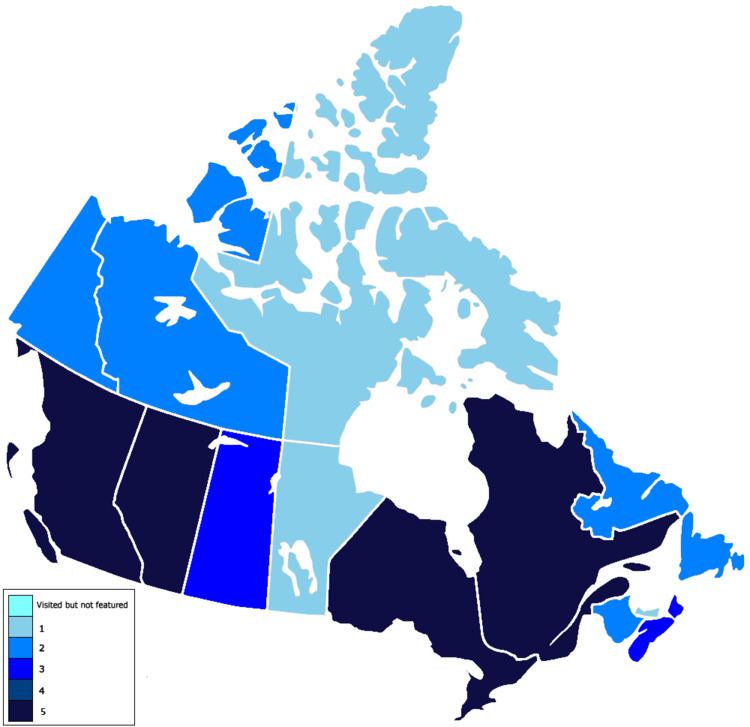Genre Reality competition Country of origin Canada | Creative director(s) Shannon McGinn Theme music composer John M. Keane | |
 | ||
Created by Elise DoganieriBertram van Munster | ||
The Amazing Race Canada is a reality television competition series that features teams in a grueling race across Canada and the world. The Race is divided into a series of legs and on each leg; teams strive to reach the Pit Stop where they are greeted by the host, Jon Montgomery. During each leg teams receive destination clues and challenges to complete in order to move onto the next task. The first team to cross the finish line wins $500,000 in cash and prizes. This prize is the largest grand prize ever awarded for a Canadian competition series. Commissioned by CTV, The Amazing Race Canada is produced by Insight Productions in association with Bell Media and with the support of Profiles Television.
Contents
- The Race
- Teams
- Route Markers
- Clues
- Obstacles
- Legs
- Non elimination legs
- Rules and penalties
- Seasons
- Places visited
- International
- References
On the airdate of the first season finale it was announced that CTV Bell Media had ordered another season of The Amazing Race Canada. Casting began in fall 2013 and the second season aired in summer 2014. New to the eligibility requirements for season 2 were clauses that applicants must possess a valid Canadian passport, and be able to travel not only within Canada but around the world, meaning that, unlike the first season, the race traveled to destinations outside of Canada, closer to its American counterpart.
The show also airs on Vrak TV translated into Canadian French as «The Amazing Race Canada: Une Course Contre la Montre».
The Race
The Amazing Race Canada is a reality television competition between at least nine teams of two. The race is divided into a number of legs wherein teams travel and complete various tasks to obtain clues to help them progress to a Pit Stop, where they are given a chance to rest and recover before starting the next leg twelve hours later. The first team to arrive at a Pit Stop is often awarded a prize while the last team is normally eliminated from the race (except in non-elimination legs). The final leg of each race is run by the last three remaining teams, and the first to arrive at the final destination wins CA$250,000, two vehicles of any Chevrolet model cars and unlimited air travel for a year with Air Canada.
In the second season, Petro-Canada and Scotiabank were added as sponsors, with the team winning a lifetime supply of gasoline from Petro-Canada. In the third season, the Bank of Montreal (BMO) replaced Scotiabank as the financial sponsor. In the fourth season, Hotels.com replaced Air Canada as the trip sponsor.
Teams
Each team is composed of two individuals who have some type of relationship to each other. A total of 42 teams, or 84 contestants, have participated in The Amazing Race Canada.
Route Markers
Route Markers are yellow and red flags that mark the places where teams must go. Most Route Markers are attached to the boxes that contain clue envelopes, but some may mark places where teams must go in order to complete tasks, or may be used to line a course that the teams must follow.
Clues
Clues are found throughout the race in sealed envelopes, normally inside clue boxes. They give teams the information they need and tasks they need to do in order for them to progress through the race.
Obstacles
Teams may encounter the following that may affect their position during the race:
Legs
At the beginning of each leg, teams receive an allowance of cash, usually in Canadian dollars, to cover expenses during the race (except for the purchase of airline tickets, which are paid-for by credit cards provided to the teams).
Teams then have to follow clues and Route Markers that will lead them to the various destinations and tasks they will face. Modes of travel between these destinations include commercial and chartered airplanes (which for this series are generally provided by sponsor Air Canada), boats, trains, taxis, buses, and rented vehicles provided by the show, or the teams may simply travel by foot. Each leg ends with a twelve-hour Pit Stop where teams are able to rest and where teams that arrives last are progressively eliminated from the race until only three teams remain. Most legs comprise three or more challenges, often a Roadblock, Detour and a Route Info Task. The first teams to arrive at the Pit Stop win prizes, usually from the show's sponsors.
Non-elimination legs
Each race has a number of predetermined non-elimination legs, in which the last team to arrive at the Pit Stop is not eliminated and is allowed to continue on the race. The non-eliminated team is required to do a Speed Bump sometime during the next leg.
Rules and penalties
Most of the rules and penalties are adopted from the American edition.
Seasons
The show first aired in 2013 with the first season premiere airing on July 15, 2013 and ending on September 16, 2013.
Places visited
As of the fourth season, The Amazing Race Canada has visited all of Canada's provinces and territories, in addition to seven foreign countries in Europe, Asia, South America and North America.
The following are the number of times places (including Canadian provinces and territories) are featured in The Amazing Race Canada.
